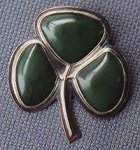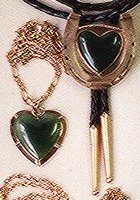|
|
|

Copyright
Working with Jade
By Tom Leedham
Polishing Jade
Thesis: any piece of jade will take a polish.
Jade varies from piece to piece in characteristics that affect grinding and polishing. If one system fails, a person must try alternatives that eventually will result in a creditable polish. Grind and polish as you would an agate, but remember, jade is softer and more fibrous than agate. Take the following precautions:
| |

Jade clover pendant.

These beautiful heart necklaces are just some of many creations by Tom Leedham.

More jade heart necklaces.
|
- Trim your piece out of the slab without pushing. Take your time. If you try to rush the sawing, you may start small edge fractures that will show up in the final stone.
- Grind to size using plenty of water. Don't push too hard or you may get a "white spot" or spread the edge fractures.
- Grind to shape using a steady turning of the stone on the wheel so that you are taking off the unwanted material without danger of enlarging any small edge fractures. Don't zip back and forth. Be on the lookout for potential "hard" spots. If they show up, carefully take them down.
- After shaping, sand with 220 grit using uniform strokes - steady but light. Check frequently. The grinding marks will disappear quickly. The shaping of the stone is the main thing.
- After you have removed all the grinding marks, change to 320 grit. Any hard spots will start to show up.
- Now change to 400 grit to work the "hard" spots down and by sanding lightly, complete the shaping.
- Change to 600 grit, use light, steady pressure to bring up to pre-polish.
- Polish On Leather Disk. First clean off the buff with a wad of wet paper towelling and squirt water on at the same time to get rid of all the old tin oxide and crud that you possibly can. Polish the stone on the leather near the centre of the disk. In other words, use slow speed. Use a squirt of water on the buff. Put a little dab of tin oxide on your stone--not on the buff. When the buff starts to dry you will get the best pulling action. You can use light pressure but get the pulling action.
If the stone winds up having irregular marks, "orange peel", lumps, hard streaks, usually the stone is telling you that you and your machine are going too fast, or, that you are using too much pressure and you are in too big of a hurry. The best alternative is a system of hand polishing. (see below).
The above instructions are based on carborundum wheels, if you are using diamond wheels, change item (4) to read 280 grit, change to item (6) using 600 grit, then on to item
(7) using 1200 grit.
Hand Finishing Jade
- Go back to the 400 grit drum and try to get a good looking shape and contour. Maybe you will have to go to 320 if it is an old belt, then to hand finishing.
- The hand finishing sequence requires "wet or dry" sandpaper. It is available in hardware stores, lumber yards, or home improvement centres, and stores that have equipment for auto body repairs.
Get grit sizes 320, 400, 600, 1200 (or ultra fine). Sheets come in 8 1/2" x 11", cut the sheets to 1/8th size, (2 3/4" x 4 1/4" to fit comfortably in your hand. Also have a piece of flat wood (such as a paint paddle) about 5" long.
Leave your stone on the dopstick.
- Use 320 grit to remove streaks or lumps. You can lay a piece on your stick, or better still, glue the sandpaper on the stick and use as you would a file. Wet the stone. (you need a cup or small container of water). Dip your stone in water and precisely and carefully sand off the high spots. Actually sand them slightly below the surrounding surface.
- Take a piece of 320 paper in the palm of your hand, wet the stone, and sand by turning the stone in the paper. With a bit of trial and error you can get a good contour.
- Go to 400, 600, and finally 1200 in your hand, being careful not to re-create the streaks, lumps, etc. By 1200 grit, the stone should have almost a polished look.
- Use a piece of leather to polish by hand. (I have an old leather from a dining room chair seat). Use the "inside" of the leather. Hold the leather in your hand, put a dob of tin oxide on it, wet the stone and rub it on the leather. As the leather dries you will feel the pulling action. Keep at it! obviously this is slower than a machine buff but you will get good results.
- Alternately, you can try your powered leather disk with light pressure in #1 speed position (close to the centre) with a little tine oxide and quite dry.
Jade takes longer to polish,
so don't give up!
Buying Jade
Quality
What do you want? The best! You are going to spend a lot to time grinding and polishing, then put your cab in a piece of fine jewellery. You want to be pleased and proud of the result. Therefore, why spend time on a piece that you got for a "bargain" and still looks that way when you are finished.
What quality do you want? Ideally you want:
- Clean bright green colour without disfiguring streaks, blotches of dark material, without muddiness or greyness.
- High degree of translucency.
- No evidence of fractures.
- No evidence of "crumbling" or of directional weakness.
- No evidence of hard streaks.
Price
What price should you pay? Your dealer prices his jade based on his judgement of quality and rarity. If you are only going to produce a few cabs, why buy a big block? Pay the premium for the best slab you can find.
What to look for
How do you find that good slab? Look at the slab dry, not when it is wet. Look at it with a strong incandescent light above and behind it. (One with a hood reflector).
- Translucency - Depending on the strength of the light source you can determine the relative translucency of different slabs. Hold the top edge of the slab on the edge of the reflector. Bring the bottom edge toward you so that you can see the range of translucency as the light penetrates into the slab. In some very translucent pieces the light will seem to go right through the width.
- Uniformity - You should also note the variations in translucency. Your selection should be the one that is most uniform.
- Colour - Look both "through" and at the slab. Is the colour a bright lively green? Not muddy or grey?
- Structural Weakness - Look at the edge again. Is the edge sharp? Are there little pieces broken out? Are there little cracks? How far into and/or through the slab do they extend.
- Surface Indications - Look directly at the surface. Is the sawn surface perfectly smooth? (excluding any saw blade marks). Are there any streaks or ridges? These could indicate hardness in streaks. Look at the surface with the light behind it. Do you detect any internal cracks? Do you see any light or dark streaks? Again these may indicate harness or softness.
Tom Leedham is a member of the Richmond Gem & Mineral Club, and the Creative Jewellers Guild of B.C.
Copyright ©1998 Tom Leedham
This article may not be copied, distributed or reprinted in any form without the author's permission. To contact the author, please use the mailing address provided below. If you are unable to contact the author, please contact the Canadian Rockhound. Authorized reprints must acknowledge the author, original source and the Canadian Rockhound, and include the website URL address of the Canadian Rockhound.
Richmond Gem & Mineral Club
c/o Minoru Art Centre
7700 Minoru Gate
Richmond, BC, V6Y 1R9
The preceding article was first published in the Fall 1998/Winter 1999 (Vol. 18, No. 1) issue of the Gem & Mineral Federation of Canada newsletter. Reprinted in the Canadian Rockhound with permission from the editor.
More on Copyright

Document Number: CR993105
|




